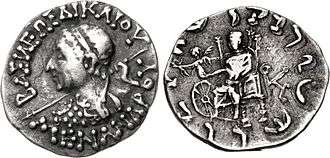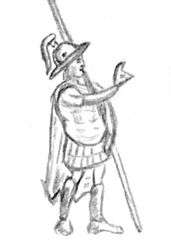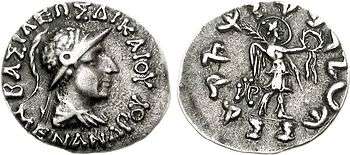Menander II
| Menander II | |
|---|---|
 Portrait of Menander II. | |
| Indo-Greek king | |
| Reign | 90–85 BCE |
| Born | Sagala |
| Religion | Buddhism |


Menander II Dikaios (Greek: Μένανδρος Β΄ ὁ Δίκαιος; epithet means "the Just") was an Indo-Greek King who ruled in the areas of Arachosia and Gandhara in the north of modern Pakistan.
Time of reign
Bopearachchi has suggested that Menander II reigned c. 90–85 BCE, whereas R. C. Senior has suggested c. 65 BCE. In that case, Menander II ruled remaining Indo-Greek territories in Gandhara after the invasion of Maues.
Relations to other kings
Menander II Dikaios may have belonged to the dynasty of Menander I Soter, the greatest of the Indo-Greek kings. It was long believed that there was only one king named Menander (see discussion under Menander I) as their portraits were rather similar and Menander II seems to have been a devout Buddhist, just as Menander I was, according to the ancient Buddhist scripture the Milindapanha.

On the other hand, the name Menander could well have been popular in the Indo-Greek kingdom, and the coins of Menander II are not very like those of Menander I nor of those other kings (such as Strato I) who are believed to have belonged to his dynasty. R. C. Senior links Menander II with the Indo-Greek king Amyntas, with whom he shares several monograms and also facial features such as a pointed nose and receding chin. He also suggests a close relation to the semi-Scythian king Artemidorus, son of Maues, since their coins use similar types and are often found together.
There is a small possibility that Menander II, rather than Menander I, is actually the Buddhist Greek king referred to in the Milinda Panha. This point is unsolved however, since Greek sources (Plutarch (Praec. reip. ger. 28, 6)) relate that the great conqueror Menander I is the one who received the honour of burial in what could be interpreted as Buddhist stupas.
More likely, Menander I may indeed have first supported Buddhism, like the other Indo-Greek kings, and was probably the protagonist of the Milindapanha, on account of his described fame, whereas Menander II, a minor king, may have wholeheartedly embraced Buddhism, as exemplified by his coins.
Coins of Menander II

Obv: Menander wearing a diadem. Greek legend: ΒΑΣΙΛΕΩΣ ΔΙΚΑΙΟΥ ΜΕΝΑΝΔΡΟΥ (BASILEOS DIKAIOU MENANDROU) "Of King Menander the Just".
Rev: Winged figure with halo bearing wreath and palm, probably Nike. The Kharoshthi legend reads MAHARAJASA DHARMIKASA MENADRASA (King Menander, follower of the Dharma).


The coins of Menander II bear the mention "Menander the Just", and "King of the Dharma" in Kharoshti, suggesting that he adopted the Buddhist faith. Menander II struck only Indian silver. These depict the king in diadem or helmet of the type of Menander I, with a number of reverses: a king on horseback, Nike and a sitting Zeus of the type of Antialkidas and Amyntas Nikator, but with an eight-spoked Buddhist wheel instead of the small elephant.
His bronzes feature Athena standing, with spear and palm-branch, shield at her feet, making a benediction gesture with the right hand, similar to the Buddhist vitarka mudra. Other varieties feature a king performing the same gesture.
On the reverse is a lion, symbol of Buddhism, as also seen on the pillars of the Mauryan King Ashoka. In general, the coins of Menander II are quite few, which tends to indicate a rather small rule.
A contemporary king to represent the Buddhist lion on his coins is the Indo-Scythian king Maues, around 85 BCE.
 Menander II as a spearholder.
Menander II as a spearholder. Menander II riding horse.
Menander II riding horse. Indian standard coin with Nike making a blessing gesture and seated lion.
Indian standard coin with Nike making a blessing gesture and seated lion.
References
- ↑ Bopearachchi 4A and note 4; Bopearachchi & Rahman -; SNG ANS
- ↑ Bopearachchi Catalogue, Pl.49 Serie 7, Q
- ↑ O. Bopearachchi, "Monnaies gréco-bactriennes et indo-grecques, Catalogue raisonné", Bibliothèque Nationale, Paris, 1991, p.453
- ↑ History of Early Stone Sculpture at Mathura: Ca. 150 BCE - 100 CE, Sonya Rhie Quintanilla, BRILL, 2007, p.9
- The Shape of Ancient Thought. Comparative studies in Greek and Indian Philosophies by Thomas McEvilley (Allworth Press and the School of Visual Arts, 2002) ISBN 1-58115-203-5
- Buddhism in Central Asia by B.N. Puri (Motilal Banarsidass Pub, January 1, 2000) ISBN 81-208-0372-8
- The Greeks in Bactria and India, W.W. Tarn, Cambridge University Press.
External links
| Preceded by Peukolaos |
Indo-Greek ruler in Arachosia and Gandhara 90–85 BCE |
Succeeded by Archebios |